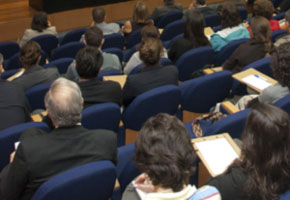

The Foundation kicks off a series of meetings with advisors that analyze the 19,000 research funding applications received annually
The Foundation kicks off a series of meetings with advisors that analyze the 19,000 research funding applications received annually.
The Foundation kicks off a series of meetings with advisors that analyze the 19,000 research funding applications received annually.

The Foundation kicks off a series of meetings with advisors that analyze the 19,000 research funding applications received annually
By Fábio de Castro
Agência FAPESP – Research funding applications received by FAPESP—some 19,000 scholarship and funding requests in 2010—are analyzed by ad hoc advisors responsible for providing statements about each application.
The Foundation began a series of meetings with advisors in November to facilitate their communication with the Scientific Board and ensure the maximum effectiveness of their statements in aiding the decision-making process.
The two first meetings were held on November 1st and 21st with the advisors who issued the largest number of statements on proposals in the areas of life sciences and exact sciences, respectively, between 2008 and 2010. More than 160 advisors were present at each meeting, in addition to coordinators from the area and adjunct coordinators from the Foundation.
According to FAPESP Scientific Director Carlos Henrique de Brito Cruz, aside from the research proposal itself, the most important documents in the decision-making process are the statements from the advisors.
He said, “We decided to invest in more effective communication between FAPESP and the advisors so that they can better understand the elements that a really helpful statement needs to have in order to aid the Foundation in making a more well-founded decision.”
Many other meetings will be held, and communication with the advisory board will be improved via a page dedicated to the topic on the FAPESP website. “The number of advisors grew from 5,000 in 2005 to 8,000 in 2010. The average time for issuing initial statements is around 25 days, and 80% of the statements are received in less than 35 days,” Brito Cruz said.
The 19,000 funding applications submitted to FAPESP in 2010 by 9,000 researchers had a 61% success rate. Brito Cruz explained, “22,000 advisory statements were used in order to analyze these proposals. The number of statements used every year grew from 15,000 in 2005 to over 20,000 beginning in 2006. As a rule, any application with a requested budget of over R$ 300,000 must have at least three statements. Any below this value get at least one.”
During the meeting, Brito Cruz showed the advisors how the FAPESP application evaluation system works to help them better understand the context in which their statements are used. He highlighted the characteristics that are most helpful to the Foundation in its decision-making process: “FAPESP expects the advisor to analyze the application’s merit. For this analysis to effectively help us, it is necessary that all the evaluations in the statement be well-founded in qualitative terms and not based on purely numerical aspects. We have an urgent need to pay special attention to the quality of the proposals instead of merely mentioning numerical data.”
The meetings also emphasized that the analysis of proposed research projects should not focus only on the question of viability. It is important to support well-structured projects that are scientifically risky when they also carry a high potential for impact.
Brito Cruz affirmed, “If the main focus is the studies’ viability, important projects may be passed by just because of their scientific risk. It helps greatly in FAPESP’s decision-making process if the advisors indicate the study’s level of scientific risk and make explicit its strong and weak points, while highlighting the attention given to means and methods so that they may, or may not, be adjusted to the level of risk indicated. We also emphasized that justified analysis of the research proposal’s originality is an essential contribution as well.”
Another factor emphasized in the meetings is that the socioeconomic and intellectual impact of the articles should be given special consideration, in addition to the number of articles or the impact of the magazines in which they were published.
“The analysis of research projects in Brazil has frequently been dominated by a merely quantitative analysis. At FAPESP, we are very concerned with the question of the intellectual and socioeconomic impacts. It is essential to the Scientific Board of Directors’ decision-making process that the advisory board give information on these impacts, which should be highlighted in the applicants’ curriculum vitae,” Brito Cruz said.
According to Brito Cruz, intellectual impact is measurable and is quite visible, in certain areas of knowledge, in the number of quotes per article. In Brazil, the number of quotations per scientific article has remained below the worldwide average over the last three decades, and this number declined even more in the last four years.
Brito Cruz noted, “This isn’t good for scientific development. We need to act through a variety of means—including analysis of projects—to show the researchers that we are looking for science with greater intellectual impact.”
Republish
The Agency FAPESP licenses news via Creative Commons (CC-BY-NC-ND) so that they can be republished free of charge and in a simple way by other digital or printed vehicles. Agência FAPESP must be credited as the source of the content being republished and the name of the reporter (if any) must be attributed. Using the HMTL button below allows compliance with these rules, detailed in Digital Republishing Policy FAPESP.





